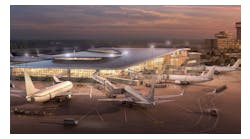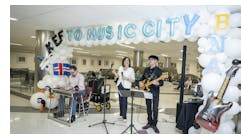Estimates show that global air traffic will grow at a rate of around 4% per annum over the next 20 years, despite disruptions to the industry from the COVID-19 pandemic. That said, there is an ever-increasing demand on the aviation industry to ensure that this is achieved in a sustainable manner. One of the key sustainability challenges is reducing aircraft noise emissions and limiting the impact on the surrounding community.
Understanding the generation of noise and, ultimately, how it can be controlled, is one of the most challenging tasks faced by engineers designing new aircraft. This unwanted sound can be attributed to both the airframe and the propulsive system of the aircraft. Any component on the airframe that induces turbulent airflow or acts as a lifting surface will produce noise. This includes, but is not limited to, the main wing and its high-lift devices, the fuselage and landing gear. Similarly, the propulsive system has several noise generating mechanisms. For medium and large civil aircraft powered by turbofan engines, sources can arise from rotating turbomachinery, the exhaust jet and the air/fuel combustion process. This article aims to provide a high-level overview of the multi-faceted aircraft noise challenge and the importance of achieving the ambitious sustainability goals for the future of aviation.
A Growing Population and Increased Air Traffic: Why Aircraft Noise Pollution Matters?
The United Nations has estimated that the world’s population, and the percentage of those living in urban areas, will continue to rise until the mid-2080s. Population growth combined with the forecasted increase in global air traffic means that there is the potential for more people to become adversely affected by aircraft noise. Furthermore, heightened awareness of the environmental, societal or physiological effects of aircraft noise all lead to a lower level of tolerance by the public.
Aircraft noise is known to affect human health and wellbeing in many ways. Research has shown that noise exposure from aviation can adversely impact the quality of individuals sleep, their cognitive performance and may also increase the probability of cardiovascular related disease. As such, the UK Civil Aviation Authority (CAA) now publishes a twice-yearly report outlining recent findings in the field of aircraft noise and its associated health effects on adults, adolescents and children. The CAA’s role includes monitoring noise around UK airports and setting industrial policies such as the CAP 2091: CAA Policy on Minimum Standards for Noise Modelling through which noise contours are modelled to assess the level of noise exposure to the surrounding community.
Ambitious Sustainability Goals for the Aviation Sector
The Advisory Council for Aviation Research and Innovation in Europe (ACARE) have established several environmental goals through the Fly the Green Deal 2050 framework and its predecessor, Vision 2020. These goals outline the need for aviation to accelerate its effort to achieve climate neutrality, reduce noise emissions and improve air quality in the face of an expanding market. It was envisaged that by 2020 aircraft technologies and operating procedures would enable a 50% reduction in perceived noise relative to a typical new aircraft in 2000.
Encouragingly, it can be said that the Vision 2020 goal was largely achieved. This can mainly be attributed to the increased bypass ratio of turbofan aircraft engines, the foremost source of noise at high power conditions, and incremental reductions in airframe noise which is a dominant source during the approach phase of flight.
Innovative Solutions to Reduce Aircraft Noise
To realise the 2050 goals, there must be a further 15% reduction in perceived aircraft noise relative to Vision 2020. A step in the right direction is made through the introduction of Ultra High Bypass Ratio (UHBR) turbofan engines such as the Rolls-Royce UltraFanTM but successfully achieving the goal will require a “balanced approach to aircraft noise management”, as highlighted by the International Civil Aviation Organisation (ICAO). This approach aligns improvements in treating the sources of aircraft noise with enhanced noise abatement procedures, operating restrictions and improved management of the land surrounding airports and alike. Ultimately, it is the ICAO that set international standards and recommended practices for type certification of civil aircraft from a noise perspective.
With regards to further reduction in the sources of aircraft noise, development of advanced propulsion systems closely integrated with an aerodynamically enhanced airframe can easily be imagined; for example, the Airbus ZEROe Blended Wing Body. This particular concept would not only benefit from a top-mounted propulsive system providing noise shielding but also from the benefits of improved aerodynamic efficiency on aircraft performance.
Alternatively, a switch to fully or hybrid-electric powered aircraft provides an opportunity to implement a distributed propulsion system consisting of multiple propellers or ducted fans placed around the vehicle. Such a configuration could remove sources of noise generated by the compressors, turbines and combustion systems that are apparent in today’s jet engines. On the flip side however, new sources such as propeller-propeller or propeller-airframe interaction could be introduced and must be dealt with diligently. This emphasises the need to develop accurate and validated engineering prediction methods, such as those offered by ESDU, to understand the noise sources of concern as early as possible thus reducing costly preventative measures in the latter stages of the design cycle.
Looking Ahead: The Path to a Quieter and Greener Aviation Future
The above reflections are based on moving toward the Fly the Green Deal 2050 European vision for sustainable aviation, the UK Aviation 2050 vision or similar, depending on where you are in the world. Aircraft noise emissions are only one piece of the sustainability puzzle, however. In recent years there has been a noticeable change in the vigour at which countries are beginning to acknowledge, comprehend and address the global climate change challenge. The Paris Agreement (2015), European Green Deal (2019) and the more recent ICAO “long-term aspirational goal of net-zero CO2 emissions from aviation by 2050” all underpin what may be the aviation sector’s greatest challenge yet.
With regards to aircraft noise, the 2050 goals are without doubt ambitious and cannot rely solely on the reduction of noise at its source. Airspace modernisation, advanced operational procedures and appropriate planning for urbanisation around airports must all be considered in a cohesive approach. Furthermore, the adoption of aggressive, but necessary, policies must be backed with sufficient funding to drive and deliver the innovative technologies in the timescales required. All of this must be achieved in the face of a dynamic and ever-changing aviation landscape.




